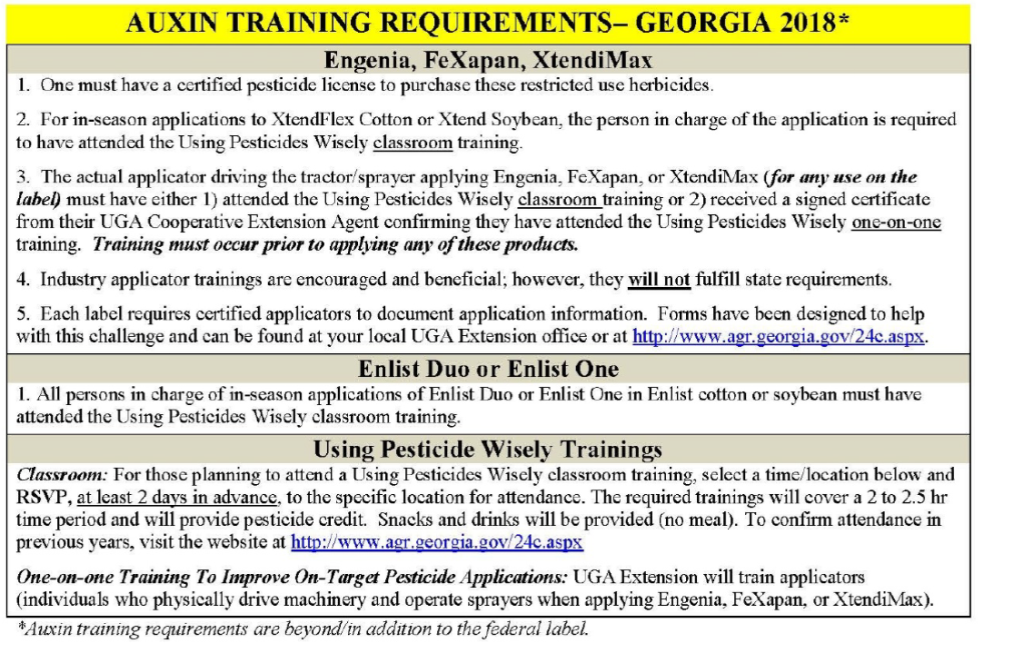Colquitt County Extension Ag Update 3-21-18
Published 9:28 am Wednesday, March 21, 2018

- Auxin training requirements
Palmer Amaranth Control in Cotton in 2018 – Laminated Handout
Below is a link to access the 2018 Palmer Amaranth Control in Cotton “laminated handout” which have been distributed for the past several years.
Palmer Amaranth Control in Cotton in 2018
2017 UGA Cotton OVT Data Summary
Cotton variety selection is an extremely important decision for cotton producers each year. Examining un-biased, research based information on variety performance is a critical part of making proper decisions. There are lots of places to find information on cotton variety performance available, and UGA works to provide producers in Georgia with a reliable place to find that information. One of the sources of that information comes from UGA’s Statewide Variety Testing Program. This program conducts Georgia’s Official Variety Tests for cotton (OVTs) each year.
The 2017 Georgia Cotton OVTs are composed of three set of small-plot trials. These three trials include evaluating a later maturing set of cotton varieties, an earlier maturing set of cotton varieties and a set of cotton strains (typically an early look at lines to evaluate for commercialization). The early and late trials are conducted on a total of eight sites (four irrigated and four dryland) at UGA Research Stations in Tifton, Midville, Plains and Athens as well as an on-farm site in Bainbridge.
Summaries from the 2017 Statewide Variety Testing Program’s Official Variety Tests for cotton are available by clicking links at the botton of this post. These summaries contain lint yield from each variety and location and ranks varieties based on overall average yield. The complete data set, which includes information fiber quality can accessed online at their website www.swvt.uga.edu.
UGA OVT Later Variety Summary 2017
UGA OVT Earlier Variety Summary 2017
UGA OVT Strains Variety Summary 2017
Update on Peanut Varieties for 2018
Dr. Scott Monfort has provided growers with information on peanut varieties. This information can be obtained below.
https://site.extension.uga.edu/colquittag/2018/03/update-on-peanut-varieties-for-2018/
New UGA Peanut RX!!
https://site.extension.uga.edu/colquittag/2018/03/2018-peanut-rx/
UGA Forage Update
Topics for the update are below.
Baleage Field Day
Alfalfa in South Workshops
Are Warm Season Native Grasses an Option?
Comparing Summer Annual Forages
Managing Internal Parasites Through Better Grazing
The Amazing Ruminant!
Upcoming Events
https://mailchi.mp/497ad66da023/august172017-1402121?e=cdf61c4fa0
Starter on Corn..
Small amounts of nitrogen and phosphorus are often used as a starter or “pop-up” fertilizer. The main advantage of starter fertilizer is better early-season growth. Corn planted in February, March or early April is exposed to cool soil temperatures, which may reduce phosphate uptake. Banding a starter fertilizer two inches to the side and two inches below the seed increases the chances of roots penetrating the fertilizer band and taking up needed nitrogen and phosphorus.
Deduct the amount of nitrogen and phosphorus used in a starter fertilizer from the total nitrogen and phosphorus needed for the season. However, total phosphate requirements of the corn crop can often be supplied in the starter fertilizer. Since nutrients applied in starter fertilizers are a part of the total fertilizer program, using this recommended practice is not very costly.
Currently, the most popular starter fertilizer is ammonium polyphosphate (10-34-0). Monoammonium and diammonium phosphates are equally effective. There is generally no advantage in using a complete fertilizer (NPK) as a starter since applying phospha te is the primary objective. There is an advantage to using additional N such as 28-0-0-5 particularly in sandy soils to encourage growth as soils warm. Depending on your needs, a typical popup application is 6 to 7 gallons each of 10-34-0 and 28-0-05, as described above.
Wheat Growth Stages: Below is a description of important wheat developmental stages
Feekes Stage 7: The second node has become visible
Feekes Stage 8: The flag leaf is visible at this growth stage. The flag leaf begins to emerge from the whole while the second node is visible. When the flag leaf has fully emerged, three nodes are now visible and the flag leaf makes up nearly 75% of the effective leaf area that contributes to grain fill.
Feekes Stage 9: Flag leaf and ligule are just visible at this stage.
Feekes Stage 10: This is the boot stage. The head is developed and can be seed in the swollen section of the sheath of the flag leaf.
Herbicide Strips in Pecans
https://site.extension.uga.edu/pecan/2018/03/herbicide-strip-applications/
Auxin One on One Trainings
The Colquitt County Extension will be conducting One on One trainings every Wednesday at 9 am at the Colquitt County Extension office. If you are interested please call the office and the phone number is 229-616-7455.
Options for Loss of Tilt, Shortage of Chlorothalonil in Peanut
• MAZINGA (2 pt/A): Chlorothalonil, Tetraconazole
• 1 pt/A Chlorothalonil + 2.5 fl oz/A Domark (Domark can be apllied to rates as high as 6.9 fl oz/A)
• 1 pt/A Chlorothalonil + 5-10 fl oz/A Topsin M
• 1 pt/A Chlorothalonil + 5.5 fl oz/A Alto
• 1 pt/A Chlorothalonil + 10 fl oz/A Eminent VP
• 1 pt/A Chlorothalonil + 7-14 fl oz/A Topguard
• 2 lb/A Koverall (mancozeb) + 14 fl oz/A Topguard
• 1.5 pt/A ELAST 400F (dodine)
• 3.5 fl oz/A Absolute
• 6.0 fl oz/A PRIAXOR (at 45 days, replaces two apps of chlorothalonil at 30 and 45 days)



